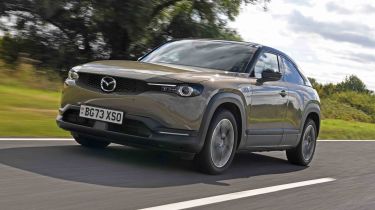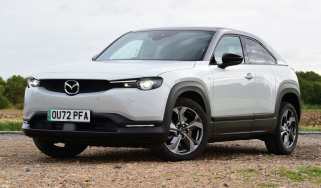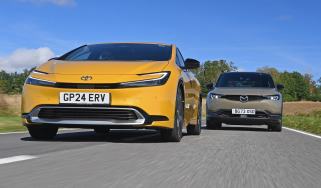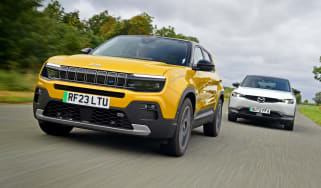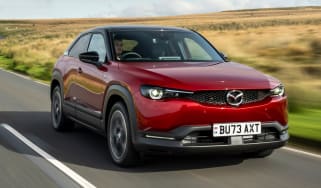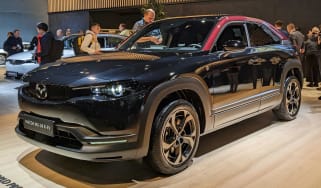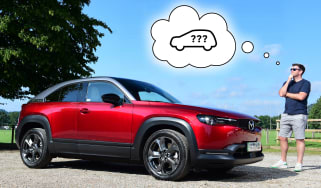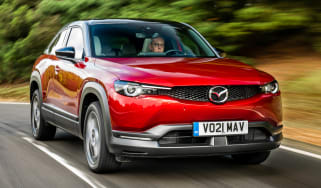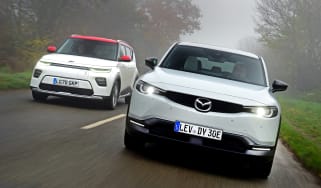Mazda MX-30 review
Stylish Mazda handles well and has a classy cabin but is compromised elsewhere, whether in electric or range-extending guise

Is the Mazda MX-30 a good car?
One thing’s for certain: the Mazda MX-30 is definitely a stand-out car in many ways, but not all of them are necessarily a good thing. Its compact dimensions mean it’s more of a crossover than a full SUV, and the rear-hinged half doors emphasise this - but they do also compromise practicality.
The Mazda MX-30 was the brand’s first fully electric car but is now also available in R-EV form with some interesting engineering under the bonnet: a tiny rotary petrol engine that charges the battery and turns the car into a range-extender hybrid. Given that the electric MX-30 was always hampered by its poor range figures, this model should offer a bit more flexibility and usefulness to those who plan to use their car for more than just commuting.
It’s the first time that Mazda has fitted a rotary unit in one of its cars since the RX-8 coupe, but unlike past models, this isn’t a sports car but a family model using it for efficiency.
| Key specs | |
| Fuel type | Electric, range-extending PHEV |
| Body style | Five-door crossover |
| Powertrain | 35.5kWh battery, 1x 143bhp e-motor, front-wheel drive 17.8kWh battery, 1x 168bhp e-motor with 830cc petrol rotary range extender, front-wheel drive, |
| Safety | Five stars Euro NCAP (2020) |
| Warranty | 3yrs/60,000 miles, 8yrs/100,000 miles (battery) |
How much does the Mazda MX-30 cost?
With prices starting at less than £30,000, the Mazda MX-30 is one of the better-value electric SUVs currently available. However, the reason it costs so little is because of the small battery that Mazda has fitted to the car – it cost less to make, so the firm can list it for less, but that’s also the reason why it has such a short range.
Used - available now

2020 Mazda
Mx-30
40,424 milesAutomaticElectric
Cash £8,900
2020 Mazda
Mx-30
26,024 milesAutomaticElectric
Cash £10,695
2023 Mazda
Mx-30
1,418 milesAutomaticElectric
Cash £14,599
2023 Mazda
Mx-30
1,786 milesAutomaticElectric
Cash £22,995If you’re interested in the R-EV instead, like-for-like you’ll have to find an extra £3,500 to get behind the wheel. For some that will be a big enough price to pay for the added reassurance of the range-extending petrol engine.
The range runs through Prime-Line, Exclusive-Line and Makoto trims, with a step of around £2,000 to move to Exclusive-Line, then another £2,500 for the Makoto model. All versions of the MX-30 come with LED headlamps, heated electric folding mirrors, front and rear parking sensors, a reversing camera and rain-sensing wipers.
Inside, there’s an 8.8-inch infotainment system that’s controlled by a central rotary knob and panel of buttons. Apple CarPlay and Android Auto are included, while Mazda’s Connected Services with the MyMazda app offers remote control over vehicle functions and relays charging information back to your phone.
Electric motors, performance & drive
Both versions of the MX-30 have the same powertrain set-up: a front-mounted electric motor with a battery pack under the floor. Depending on which model you choose, you get a 35.5kWh battery in the full EV, or a 17.8kWh unit in the R-EV. The EV’s battery is on the small side so the car’s range isn’t great, but that version is aimed at those with a short commute.
If you need more range, then the R-EV model adds a rotary engine under the bonnet plus a 50-litre fuel tank so that the smaller battery can be recharged when on the move. This boosts the MX-30’s range to more than 400 miles.
The rotary engine will be familiar to fans of Mazda’s sports cars. It uses an oval-shaped combustion chamber with a rounded-triangle that rotates within it. Where a piston in a normal engine goes up and down with explosions that are converted mechanically to a rotational force, rotary engines spin around a central point and are super-smooth as a result.
It means you get hardly any vibration, even at high revs, which is a great way to charge a battery as a generator. The MX-30’s R-EV set-up works in the same way as the old BMW i3 REx range extender, where the wheels are only ever driven by the electric motor, and the engine comes on automatically to charge the battery when it’s needed.
While the R-EV model is a bit heavier than the pure-EV MX-30, it’s also more powerful. The EV has 143bhp to offer, but the range extender increases that to 168bhp.
| Model | Power | 0-62mph | Top speed |
| MX-30 EV | 143bhp | 9.7 seconds | 87mph |
| MX-30 R-EV | 168bhp | 9.1 seconds | 87mph |
What is the Mazda MX-30 like to drive?
The Mazda MX-30 is a composed car with a fine balance of comfort and handling, just like pretty much every other Mazda. It’s clear as soon as you get behind the wheel that the brand takes the driving experience seriously because the MX-30 is comfortable and smooth, has excellent control weights and a great driving position, while it also has a classy, high-quality feel.
In town
The MX-30 rides well over bumps, and the comfortable driving position means you won’t feel anything but the worst potholes around town. The electric motor is quiet and getting up to 40mph or so is swift, although the 0-62mph time of 9.1 seconds shows that once you’re above that, acceleration drops off quite a bit. It’s not slow, but other EVs and hybrids offer better acceleration up to the national speed limit.
The main issue with the MX-30 R-EV is that although the rotary engine is smooth and free from vibration, it’s noisy. It doesn’t sound appealing like the old rotaries in Mazda sports cars, but just reminds us of a generator motor at a fairground. It whirrs away in the background with a droning tone. Considering how quiet the rest of the experience is, it’s noticeable when it starts charging the battery.
The electric parking brake has an auto-hold function and comes on automatically when you shift into park. However, it doesn’t automatically disengage when you try to pull away, which is a quirk that takes some getting used to.
On A- and B-roads
At higher speeds, the R-EV’s motor is drowned out by wind and road noise, although those aren’t much of an issue in the MX-30 overall. Rather, you’ll start to enjoy the car’s well-weighted steering and smooth ride, as country roads are where it excels.
On twisty roads, the Electric G-Vectoring Control Plus (e-GVC Plus) system works away in the background, adjusting the electric motor’s torque to aid handling. Combined with good reserves of grip, the MX-30 feels reassuringly stable and easy to place.
It’s no sports car, but the Mazda is satisfying to drive, with good body control through corners despite the soft suspension. The regenerative braking feels natural and you’ll hardly notice it doing its job because the pedal feel is pretty good at all times.
There are differing intensities on offer that are adjusted via the steering wheel paddle shifters. The car’s braking performance generally feels very natural, with predictable stopping power and pedal feel, while the graduated modes are never jerky and mean you can set a level of regenerative braking you’re comfortable with. None of the settings have the one-pedal driving strength of Nissan’s e-Pedal system – even the highest setting.
On the motorway
While the electric motor starts to feel a bit weedy at higher speeds, that’s no issue in the MX-30 R-EV for motorway driving; it’s as good as it needs to be. The ride is smooth at high speed, and wind and road noise are tolerable – it’s not noticeably hushed at 70mph, but nor is it particularly noisy.
0-62mph acceleration and top speed
With 143bhp on tap and 271Nm of torque, the all-electric MX-30 can sprint from 0-62mph in 9.7 seconds and has a top speed of 87mph. That’s fast enough acceleration for most needs, but if you want more, then the R-EV has 168bhp and 260Nm of torque (in part to help compensate for the extra weight of the hybrid powertrain) and can sprint from 0-62mph in 9.1 seconds. The top speed of this version is also 87mph.
Range, charging & running costs
The main issue that pegs the Mazda MX-30’s appeal back is its short range. The official figure is 124 miles, which is behind its rivals, and in the real world we found a range of around 110 miles was more realistic.
The range-extending MX-30 R-EV offers a longer range thanks to the addition of a petrol engine, but even this version only makes the most sense if you don’t use it frequently for long trips, because that’s where it’s the least efficient.
| Model | Range/MPG | CO2 | Insurance group |
| MX-30 EV | 124 miles | 0g/km | 19 |
| MX-30 R-EV | 282.5mpg | 21g/km | 22-23 |
Electric range, battery life and charge time
The MX-30 uses a relatively small 35.5kWh battery, so it charges at a home plug quite quickly. It can draw up to 6.6kW, so a 0-100 per cent charge takes five-and-a-half hours in the electric model, or just two-and-a-half hours for the R-EV on a home charger. Using a three-pin plug increases those figures to 15 hours, 30 minutes and seven hours, 30 minutes respectively. You can use an app called MyMazda to connect to the car and see its charge state among other options.
The range-extender MX-30 has a surprisingly large fuel tank at 50 litres, so along with just over 50 miles of all-electric range from the 17.8kWh battery you could drive for a total of about 420 miles with a full tank of fuel, according to official figures. It’s all about convenience here because on a long trip you can choose to fill up with fuel rather than having to stop and charge, as you would with the electric version.
Mazda provides both versions of the MX-30 with a pair of Type 2 charging cables as standard, one for charging from a domestic 3-pin plug socket and a second for use with public and wallbox chargers, while 50kW DC charging is available that can take the EV from 20-80 per cent capacity in 26 minutes.
Tax
All MX-30s duck below the £40,000 mark so they avoid the expensive car supplement, while company car tax costs are low as well. Lower-rate taxpayers can expect to pay just £573 for Benefit-in-Kind tax in the 2024/25 period for the top-spec R-EV Makoto version, for example, and that’s the most expensive model in the line-up. The electric models cost even less, with a maximum cost of £129 in the 2024/25 tax year for 20 per cent rate payers.
Insurance groups
All electric MX-30s are in at least insurance group 19, which is reasonable for a pure EV because they tend to sit in higher groups than the equivalent petrol or diesel models. The R-EV version is slightly more expensive to cover, because the groups rise to 22 for the mid-range Prime-Line and 23 for the range-topping Makoto model.
Depreciation
Our data shows that the MX-30 loses a chunky 67 to 71 per cent of its value over three years or 36,000 miles, and it’s the top-spec Makoto R-EV that’s hit the most. This is bad for the first owners, but could make the MX-30 a used bargain in the future.
To get an accurate valuation for a specific model, check out our free car valuation tool...
Interior, design & technology
Mazda interiors have been a high point for years and the MX-30’s is no exception, since it has a high-quality feel. It’s a simple interior that looks elegant and the quality is excellent.
What is the Mazda MX-30 like inside?
Those who appreciate small details will love the MX-30’s interior. There are some normal materials that look and feel good alongside some neat touches such as cork used in several places. This is a reference to the brand’s origins in the 1920s as a cork supplier. It looks strange in a car, but it works and gives the car a unique feel. The door fabric uses fibre from recycled bottles, too.
What is the interior quality like?
Build quality is superb; you won’t hear any rattles as you drive and the controls feel good to use. It’s a shame that some of the climate functions are within a touchscreen menu, since other switches and controls are nice to use. It’s unlike Mazda to compromise usability like that, so it’s a little disappointing to see in a model like this. The cloth seats feel more upmarket than leatherette ones, but they don’t have the same wipe-clean nature so might not last as well over years of use.
Sat-nav, stereo and infotainment
The MX-30 uses two small screens on the dash instead of one huge one like many modern EVs. There’s a seven-inch display on the console to control climate functions and a larger 8.8-inch screen on top of the dash that houses the rest of the infotainment. Functions include sat-nav, DAB, Apple CarPlay and Android Auto, and it all works well thanks to a rotary controller on the centre console with shortcut buttons.
The upper display has a widescreen layout, so it looks bigger than you might expect, and the control wheel system is easy to use. However, the climate controls on the lower screen are frustrating because they’re harder to use.
Boot space, comfort & practicality
The MX-30 R-EV isn’t a practical car if you carry a lot of luggage or passengers, despite looking like an SUV. It technically has five doors, but if you treat it as a three-door, you will set your expectations closer to reality.
Dimensions and size
The MX-30 falls somewhere between a compact hatchback and an SUV in terms of size. It’s roughly the same length as a Vauxhall Astra, but is narrower and has a taller ride height. The wheelbase and rear overhang also add to the SUV-style proportions, and this has an impact on the interior layout, especially when it comes to rear passenger and boot space.
| Dimensions | |
| Length | 4,395mm |
| Width | 1,795mm |
| Height | 1,555mm |
| Number of seats | Five |
| Boot space | 332 litres (1,137 litres with seats folded) |
How practical is the Mazda MX-30?
Seats & space in the front
The MX-30’s front seats are excellent: they offer plenty of support and adjustability, so people of all sizes should be able to get comfortable. Even taller drivers will find loads of room up front and headroom is no issue. There’s a decent amount of storage space, with a useful centre console cubby and a hidden section beneath where you can plug your phone into the USB ports out of sight. There are cup-holders under cork-lined flaps, and a storage bin under the armrest.
Seats & space in the back
Access to the rear is awkward because the doors are hinged at the back and are about half-sized. Plus, you need to open the front door to access them in the first place, in order to reach the handle. Once in the back, there’s not much space for adults. Legroom is poor with the driver’s seat set to a normal position, and headroom isn’t great either, although you should still be able to sit without your head touching the roof. There’s not much foot space either. It’s really only suitable for kids or short trips, rather than something that can be used every day.
Boot space
The MX-30’s boot capacity is 350 litres as standard but gets reduced to 332 litres in higher-spec cars with the Bose stereo, because there’s a subwoofer under the floor. You can fold the seats down to open up 1,137 litres in total, which is decent enough. The boot shape is nice and square but the sloping rear screen means it’s not quite as roomy as it looks if you have a tall item that needs to go in. The charging cables don’t have a dedicated spot and there’s no front boot either, so you’ll need to store them in there as well.
Reliability & safety
Driver-attention alert, blind-spot monitoring, emergency lane-keep assist and lane-departure warning are all standard on the MX-30, plus there’s a five-star safety rating from Euro NCAP. The Makoto model also gets Smart Brake Support Rear, which prevents low-speed collisions when reversing, adaptive headlights and rear cross-traffic alert.
When tested in 2020 the Mazda received 91 per cent for adult occupant protection, 87 per cent for child occupant protection, 68 per cent for vulnerable road user protection and 73 per cent for safety assist tech. Mazda finished a very healthy seventh in the 2024 Driver Power manufacturer poll.
| Key standard safety features | Euro NCAP safety ratings |
|
|
Warranty
All Mazdas come with a three-year/60,000 mile warranty, which is fairly average in the new-car market. The drive battery has an eight-year/100,000-mile warranty for added peace of mind. Mazda offers an extended warranty at extra cost, and this can be transferred to a new owner if you need to sell the car on.
Servicing
Mazda offers a service plan for the MX-30, but the price you pay will be determined by which version you choose. The MX-30 EV costs £400 for three years of maintenance, while the R-EV version costs around £850 over three years. Buyers must take out a service plane within a month of purchase, but the price can be bundled in with any finance plan that’s been taken out.
The extra outlay for the R-EV can be accounted for by the rotary engine that’s added to the powertrain, since this will need an annual oil change like any other conventional petrol engine. The way the rotary engine is used here should mean it’s as reliable as possible, which hasn’t always been the case in rotary-powered sports cars in the past, which have had high oil consumption and short, expensive service intervals.
Mazda MX-30 alternatives
With its limited range and compact dimensions, there isn’t really a direct alternative to the Mazda MX-30. The car is similar in size (if not price) to Mazda’s own CX-30, so small SUVs such as the Hyundai Kona and Kia Niro could be considered, although both of those cars easily outrank the MX-30 for range.
Looking at the MX-30 price wise, and it equals the likes of the Fiat 500e and Vauxhall Corsa Electric. It also has similar cabin space to those two, although there is a larger boot on offer.
The MX-30 R-EX is also a fairly unique proposition, because most of its plug-in rivals are hybrids, rather than being range-extending models. Of these, the latest Toyota Prius offers quirky looks, while cars such as the VW Golf eHybrid, Peugeot 308 and Vauxhall Astra are more conventional (and therefore more user-friendly) in their five-door hatchback design.
Frequently Asked Questions
R-EV stands for Range-Extending Vehicle, and this version of the MX-30 is the one with a petrol engine on board. It’s a rotary unit (similar to the engines used in the RX-7 and RX-8 sports cars), so it’s compact, while it acts as a generator that recharges the battery; it never actually drives the wheels directly. There’s a smaller battery in the R-EV to make room for the range-extending running gear, but there’s a theoretical range of around 400 miles, compared with the 124 miles possible in the electric MX-30.

